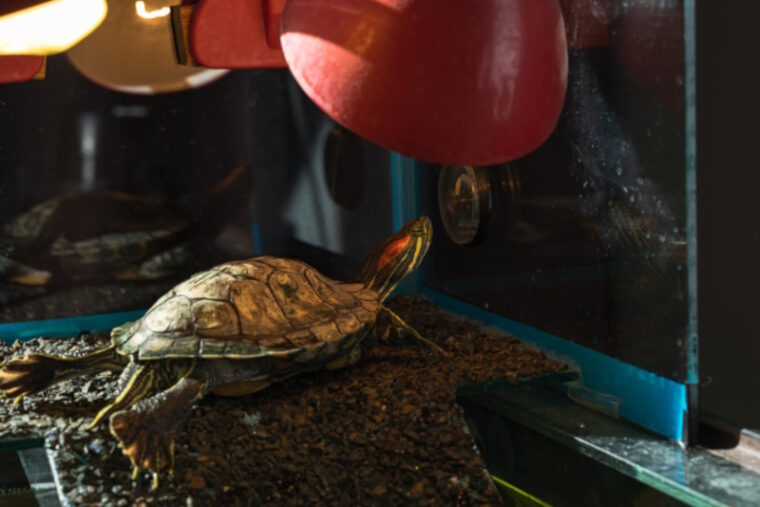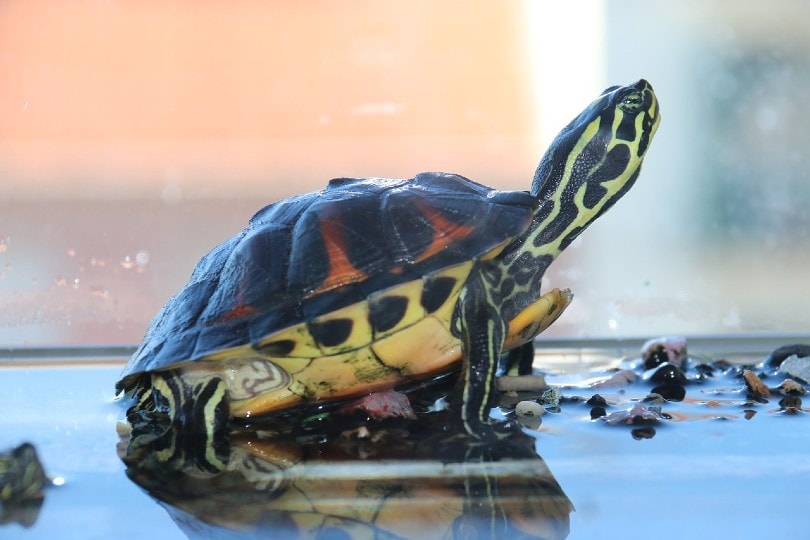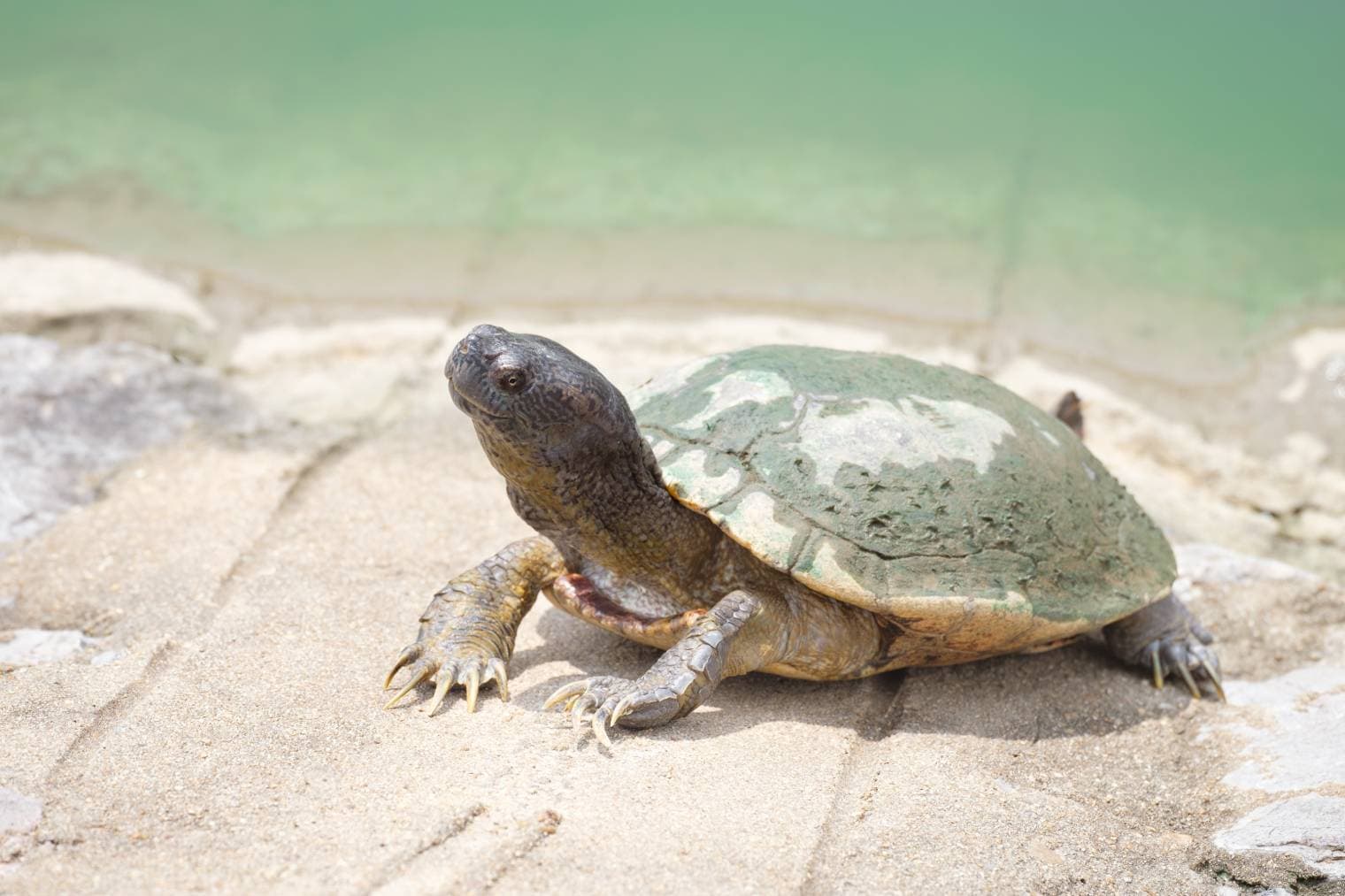
Although your turtle might be able to survive a few weeks without a heat lamp, it isn’t healthy. A lack of heat can quickly lead to health issues, and basking lights should always be provided in your turtle’s enclosure. Turtles require ultraviolet light (UVA and UVB) as well as an adequate source of heat to bask in. UVB light is more important than UVA, though UVA may also offer turtles benefits.
Always have bulb replacements handy so that your turtle receives a proper amount of light and heat. For more advice on how to create a good home for your turtle, keep reading below.
The Importance of Heat and Lighting
Providing heat and light is an essential part of your turtle’s care. Without these elements, your turtle may not thrive.
Heating
Turtles are cold-blooded, and they cannot regulate their body temperature like humans. Without a source of adequate heat, your turtle will be unable to warm up, which could cause it to go into brumation. While this is a natural ability of the turtle, that doesn’t mean it is always safe. If a turtle unexpectedly falls into brumation, it may experience significant health consequences.
Turtles typically lose up to 7% of their body weight during brumation. If your turtle unexpectedly goes into brumation, they may lose an unnecessary amount of weight, which can be detrimental for a growing individual. Unlike mammals that fatten up before hibernation, turtles and other reptiles do not fatten up before brumation.

Lighting
UVA and UVB lighting are essential for your turtle’s health. Without UVB, your turtle would be unable to synthesize adequate amounts of vitamin D. Vitamin D is a crucial part of your turtle’s mineral processing, as it facilitates calcium absorption through the digestive system.
Even if your lightbulbs are still shining, you should change them every 6 to 9 months. The power of the lights can dim over time and cause your turtle to receive an inadequate amount of UVA or UVB. Similarly, UV rays will not travel through glass, plastic, or plexiglass, so make sure that the light has direct contact with your turtle’s enclosure. However, the light should not be too close, or it can harm your turtle.
Basking
The temperature and lighting are necessary for basking, but the basking location is just as important. Make sure there is a basking spot inside your turtle’s enclosure where they can fully emerge from the water to dry out and warm up. Without sufficient space, your turtle will not be able to bask properly.
Basking spots can be made of rocks or driftwood. They can also be commercially made platforms, which you can purchase online or at most pet stores. A basking spot is usually 5 °C (9 °F) higher than the turtle’s ambient comfort temperature. For example, a red-ear slider’s preferred environmental temperature is 22–27 °C (71.6–80.6 °F). Therefore, their basking spot should be around 27–32 °C (80.6–90 °F).
How to Create a Good Home for Your Turtle
To take the best care of your turtle, these factors should be considered.
Cage Size
The size of your turtle’s cage will depend on your pet’s size, age, and sex. Baby turtles or small turtles will do well in an enclosure that is 20 to 30 gallons. However, larger turtles often require more space. The tanks can be as little as 60 gallons or as large as 120 gallons.
Believe it or not, turtles are adept at climbing. Therefore, you will need a tall enclosure to prevent your pet from becoming an escape artist. A screened lid can be a helpful feature to keep your turtle safe inside.
Most turtles need around two-thirds of their enclosure to be water. The rest should be dry land, where the turtle can rest and bask itself. The depth of the water should be around double the length of your turtle’s shell so that it has room to dive and right itself if it flips on its back.

Proper Filtration
There are several different types of filtration systems that you can use in your turtle’s enclosure. Generally, the best water filters use mechanical and biological filtration. You can use a water quality test kit to verify that the quality of your turtle’s water is just right.
Enrichment
Entertainment and mental stimulation are essential parts of any pet’s care. For turtles, enrichment can include places to hide or climb, such as hollow logs or rocks. Just be sure the hiding spots are large enough that your turtle cannot become trapped beneath them, especially underwater.
Plants can provide enrichment for your pet; however, ensure they are turtle-friendly before placing them in your enclosure since your turtle may try to eat them.
Avoid fake plants that can be nipped at or consumed by your turtle. If consumed, artificial plants may lead to gastrointestinal issues.
Correct Substrates
Suitable substrates for the dry portion of your turtle’s enclosure include biodegradable materials such as reptile mulch, coconut husk, soil, and bark. Your turtle’s substrate should be changed out each month.
For the aquatic part of the enclosure, you can use river rocks as substrate. Make sure the rocks are larger than your turtle’s head since it may try to eat them otherwise. Unless you are opting for aquatic plants, aquatic substrate isn’t a necessity.
What to Avoid When Setting Up Your Turtle’s Home

When putting together your turtle’s enclosure, there are a few elements that you should avoid.
Excessive Heat
While heating is essential for your turtle’s well-being, too much of anything can be harmful. To avoid overheating your turtle, place two thermometers in their habitat: one close to the heat source and one far away from it. This will give you an accurate temperature reading of the hottest and coolest parts of your turtle’s enclosure, and you will know if you need to adjust the temperature up or down.
Dangerous Plants
If poisonous plants are placed in your turtle’s enclosure, your pet may experience severe health consequences. Sadly, compared to other pets, there is not as much research on which plants can cause toxicity in turtles. Therefore, it is best to avoid plants that are toxic to other animals and plants that you are unsure of. Instead, stick to the plants that are proven to be safe.
Some Turtles Have Special Needs
While considering the advice in this article, remember that there are many types of turtles. Each species has their own unique needs and thus requires special care. The best way to determine what is suitable for your turtle is to consult your vet and research your turtle’s species.
Final Thoughts
Turtles are adorable yet graceful creatures that make excellent companions. They are fun to observe and care for, and while many may believe they are low-maintenance pets, that is not necessarily the case. All the components of your turtle’s enclosure must be carefully maintained, such as the heating, or troubling health conditions may arise. In the right conditions, a turtle can live for decades.
Featured Image Credit: Liubov Sydorenko, Shutterstock








